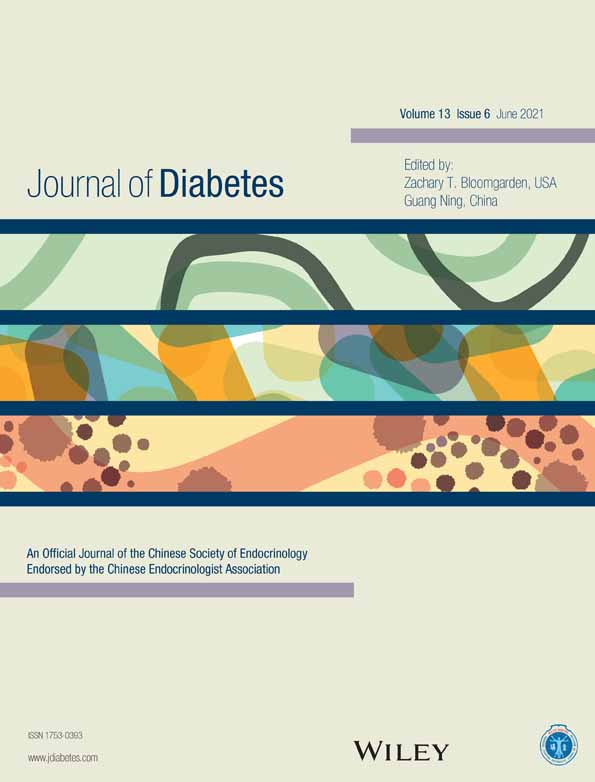Celiac disease: A global survey
乳糜泻:一项全球调查
Celiac disease (CD) is an autoimmune disorder with a strong genetic component characterized by small bowel inflammation with villous atrophy.1 Multiple studies over the past five decades attest to the higher prevalence of CD among youth with type 1 diabetes.2, 3 The study of factors associated with CD prevalence in different countries published in the current issue of the Journal of Diabetes is based on the Better Control in Pediatric and Adolescent Diabetes: Working to Create Centers of Reference (SWEET) registry, analyzing data from 74 centers screening for CD with tissue transglutaminase (tTG-A) and/or endomysial antibody (EMA) measurement, typically with confirmatory duodenal biopsy. Among >57 000 youth with type 1 diabetes, >2600 children were found to have CD, diagnosed at a median age of 8 years and an average glycosylated hemoglobin (HbA1c) of 7.98%.4 As previously reported in the literature,5 more females than males had CD in the SWEET registry, and interestingly both younger age at diabetes diagnosis and longer duration of diabetes were associated with higher prevalence of CD, the latter suggesting that screening might appropriately be continued beyond 5 years after diagnosis, although both the American Diabetes Association6 and the International Society for Pediatric and Adolescent Diabetes guidelines7 recommend screening for CD only until 5 years after diagnosis. The Letter in the current issue of the Journal of Diabetes notes that one-third of the 33 type 1 diabetic youth found to have CD at our institution were indeed diagnosed more than 5 years after diabetes onset.8
Once diagnosed, CD treatment requires a strict gluten-free diet, which can be challenging in the context of otherwise complex diabetes management. CD may make glycemic control more difficult, potentially increasing both hypoglycemia and hyperglycemia, although in the SWEET study HbA1c with CD was somewhat lower than among the remainder of the population, perhaps due to the more intensive management and monitoring required. A potential adverse effect of CD on bone mineral metabolism and linear growth is suggested by the shorter height and lower weight SD scores found in the CD patients. A recent study suggests, however, that a gluten-free diet may not adversely affect young adults' perception of wellness or health-related quality of life.9
The striking finding in the SWEET study is that CD prevalence varied more than 3-fold by region, from 1.9% in Asia and the Middle East to >6% in Australia/New Zealand and in North America. Differences in screening approaches seem unlikely to explain this, given the prospective and standardized approach taken in the registry. Differences in diet may explain part of the variability, as the predominantly rice-based diet in Asia would have lower gluten content. Might population differences both in human leukocyte antigen (HLA) and in non-HLA gene prevalences be explanatory factors? Recent studies suggest that dysbiosis of the gut microbiome may play a role in the pathogenesis both of CD and of type 1 diabetes.10 Might such a role of the gut microbiome contribute to regional variations in CD prevalence? Regardless of the mechanism, it is gratifying that in the present age of molecular medicine large clinical studies such as the present report continue to add to our understanding and to suggest novel approaches to disease management.
乳糜泻(CD)是一种自身免疫性疾病,具有很强的遗传性成分,以小肠炎症和绒毛萎缩为特征。过去50年来的多项研究证明,在患有1型糖尿病的年轻人中,CD的患病率较高。发表在本期杂志上的基于SWEET注册的关于不同国家与CD患病率相关因素的研究,分析了74个中心的数据,通过组织转谷氨酰胺酶(tTG-A)和/或肌内膜抗体(EMA)检测进行CD筛查,典型的确诊方式为十二指肠活检。在超过57000名青年1型糖尿病患者中,有超过2600名儿童被发现患有CD,被诊断的平均年龄为8岁,平均糖化血红蛋白(HbA1c)为7.98%。正如先前文献所报道的,在SWEET统计的数据中,女性比男性更多地患CD。有趣的是,糖尿病诊断年龄越小,糖尿病病程越长,CD的患病率就越高,建议CD的筛查可在确诊糖尿病后5年以上继续进行。尽管美国糖尿病协会和国际儿童和青少年糖尿病协会指南都建议只有在确诊后5年才进行CD筛查。本期杂志的文章指出:在我们单位发现的33名患有CD的1型糖尿病青年中,有三分之一确实是在糖尿病发病5年后才被诊断出来的。
一旦确诊,CD治疗需要严格的无麸质饮食,在其他复杂的糖尿病治疗背景下,这可能是具有挑战性的。CD可能会使血糖控制变得更加困难,可能会增加低血糖和高血糖,尽管在SWEET研究中, CD患者的HbA1c略低于其余人群,这可能是因为需要更严格的管理和监测。CD患者的身高和体重SD得分较低,提示CD对骨矿物质代谢和线性生长有潜在的不良影响。然而,最近的一项研究表明,无麸质饮食可能不会对年轻人的健康或与健康相关的生活质量产生负面影响。
SWEET研究的惊人发现是,不同地区的CD患病率差异超过3倍,从亚洲和中东的1.9%到澳大利亚/新西兰和北美的>6%。考虑到登记时采取的是前瞻性和标准化方法,筛查方法的差异似乎不太可能解释这一点。饮食上的差异可能解释了这种差异的部分原因,因为在亚洲,以大米为主的饮食中麸质含量较低。人类白细胞抗原(HLA)和非HLA基因患病率的人群差异是否可以作为解释因素呢?最近的研究表明,肠道菌群失调可能在CD和1型糖尿病的发病机制中起作用。肠道微生物群的这种作用是否会导致CD流行率的地区差异?不管机制如何,令人欣慰的是,在当今的分子医学时代,像本期报告这样的大型临床研究将继续加深我们的理解,并提出新的疾病管理方法。




